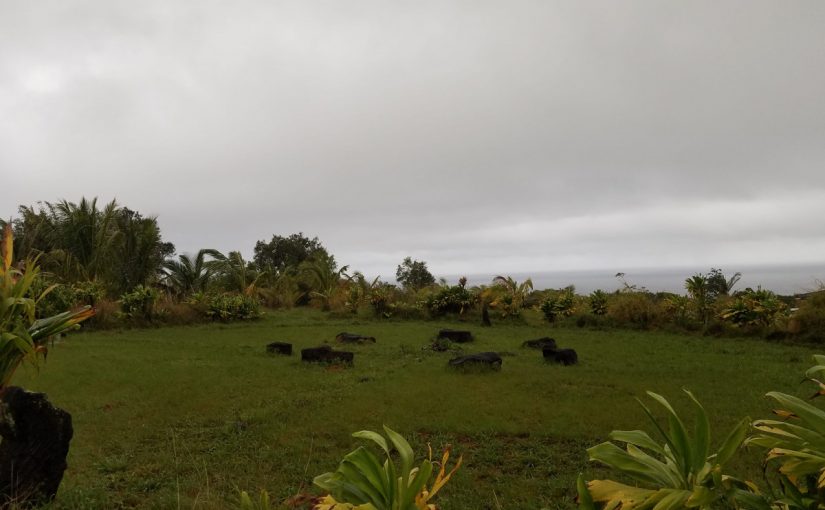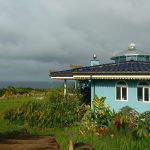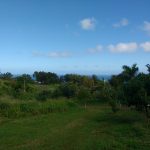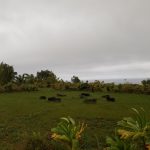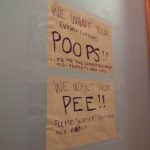This week the water showed herself, but electric inspiration filled me up.
I’ve had a hard time feeling grounded lately. There has been a constant flow of work, education, exciting trips that combine both, and integration into the Maui community with her enticing overflow of celebrations. We’ve arrived at Ahimsa, and it’s pouring rain. We wait a few moments and as the rain clears a bright blue building is revealed, trimmed with ornate gold and topped with a giant lotus flower and crystal. We’ve arrived at a sanctuary and temple- of which the community kitchen lounge we are able to come together in. An indoor kitchen, couches, and even a pool table? That certainly makes camping a little easier to do for so long. I’ve set up my tent near a pond for the privacy it keeps.
The final weeks to really dial into our design capabilities are near. We have lectures in the tea house on the technicalities of designwork like map graphics, map orientation, and clarity. Jenny is leading the week since Evan has work to do in Colorado, and she is giving us bountiful knowledge from her years of experience with permaculture consulting. The prominent theme of the week is how to analyse “invisible structures” which exist socially, financially, within governance, and legally. This firstly includes the restrictions of resources, zoning laws, and acknowledging or interviewing clients and who else has a stakehold in the land. However, permaculturists need to dig deeper and practice dynamic analysis by connecting with all of those who will be on the land- understanding their motivations and designing to encourage social community. Jenny showed us an example of this with a design she did for a village model in the bush areas by a river. She designed the village to be made of connecting pods with huts gathered in a round pattern. This creates a small community of each pod and with their focus connectivity provides line of sight for protection from any person that would have to travel through the middle of each pod to get to any huts. Jenny also understood that the women built their community with eachother when they went to wash clothes and tell stories in the river- a vital location for them with the prevalent oppression of men in that particular culture. Because of this, she designed “secret” trails branching off from each pod toward the river so that the woman may leave quietly without speculation of the men. Another way to design for invisible structures would be to have community spaces for farmworkers- and put this near the tool shed or include an enjoyable spot with shady trees for them to take breaks while working. This increases efficiency of their work because they can put their tools away when they lunch or because they have a more pleasant space to hold in between work.
We also had Forrest, a staff member on the team, teach us more about seeds and seed saving. I never knew how many species had been lost and it has inspired me to spend time saving seeds (as long as they are true to seed) from my own garden for guerilla gardening and sharing with my community. The first seeds I could save might be from an ashwagandha shrub- a plant that I did extensive research on for my plant profile project. I chose a plant that grew on Evan’s farm because during a tour of the herb garden there I was told of it’s healing abilities for fibromyalgia which is one of the autoimmune diseases I have. As I was helping cook that day two of my peers made me a tincture with it and calendula to help my chronic pain. So this week I dove into its roots and the magical abilities of this Aryuvedic medicinal herb. We were also asked to make a guild of harmonious plants to support it and I did so with plants and trees that can also be grown in the Pacific Northwest that harbor healing medicines for the nervous system. I even came up with a way to organize my guild based on each plant’s elemental correspondence and that element’s relationship to each direction; North=Earth, East=Air, South=Fire, and West=Water. This partly may have been inspired from honoring the directions and elements in the medicine circle meditation that our host, Blue Mountain, gave us at that area of our tour.
On Friday, Ahimsa hosted a private water ceremony that our class was invited to join. The ceremony was a lament for the waters that were redistributed from the natural land of Maui and rights of Kalo (Taro) farmers instead to be used for commercial pineapple and sugar cane plantations. This night was also a celebration for the healing that water provides and a hope that they will run freely again. Local musicians and practitioners performed water ceremonies/songs of their own- though many knew that stronger connections needed to be made to the native Kalo farmers who were not present though they were invited. In the end a magnetic band of indigenous people from the New Zealand island of Mauri performed and enlivened the audience with their respect to their gods and all gods we must work with to protect and respect the water. After this I was inspired to use the water the way I know best- by starting a painting from watercolors.
The water can be furiously fierce as well and as the rain continued my tent became too flooded for me to sleep in. I moved to sleep in one of the group vans we have, but all the magic of this week didn’t dampen my inspiration. After the hands on work of one day, Jenny pulled all of the women in our group aside to take us on a moderate hike to a beautiful secret spot. Down we went and eventually found a beautiful space where the river lets out to the ocean. Surrounded by lush trees on this small rocky shore, we dipped ourselves into the water and I let the frustrations of the first few weeks wash away with the flowing river. I am so grateful that she held space for us to just exist and feel mama ocean in the beautiful place we have made a home from on Maui.
